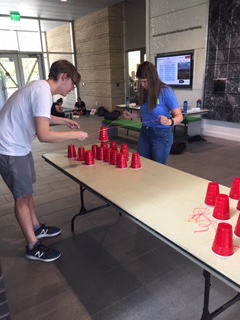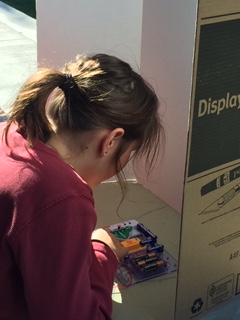
Mrs. Peabody’s 4th Grade Class, a team comprising Arianna Guzman, Melanie Schultz, and myself, participated in the first Mines Benders puzzle hunt on the Colorado School of Mines campus in Golden. The three-hour event attracted about 30 teams, most of which were made up of Mines students. MP4GC fared well, finishing in eighth place and earning a prize and mention at the awards ceremony.

Mines Benders was organized by Golden Escape Room owners Arwen and Jason Pond. The event was modeled after Microsoft Puzzle Safari (Arwen is a former Microsoft team member) and the puzzles were actually borrowed from a previous Safari event. Each team started the hunt with a packet of 32 puzzles and a log book. Teams solve puzzles and input the answers on the puzzle hunt website. If the answer is correct, the team is given the location of a rubber stamp and, in some cases, the location of a ticket somewhere on campus. Teams can send a runner with the log book to the locations to stamp the corresponding puzzle and collect the ticket. The tickets are used to participate in bonus challenges that involve engineering, physical dexterity, or teamwork. These challenges ranged from houses of cards and tilt mazes to a blind communicate challenge in which one teammate gave instructions to another, separated by a physical barrier, to build a radio transmitter. The puzzle set also included a set of puzzles that fed into a metapuzzle. Solving a puzzle scored 1 point. Collecting a stamp scored 10 points. Completing a bonus challenge received a sticker. This sticker would be placed in the log book to score 25 points. Solving the metapuzzle scored … I think it was 25 points but I’m not sure I’m remembering that correctly. The log books needed to remain intact. Log books also needed to be submitted to the organizers before the three-hour time limit expired.

The event was designed for teams of four, and boiled down to a challenge of optimization and resource management. A typical team would not be able to solve all 32 puzzles within the time limit and need to decide how to assign its members to the solving, running, and challenge completion tasks. A team wanting to maximize score would do well to assign one member to be a dedicated stamp collector and, early on, a challenge evaluator. In evaluating challenges, the runner would inform advise the team on the challenges worth pursuing (single-participant, short-duration) and those worth skipping (double-participant, time-consuming).

So why did MP4GC finish in eighth place? We were weak in areas and strong in others. Some weaknesses were uncontrollable. We had a fourth teammate who had to bow out at the last minute. The hunt required Internet access for puzzle research and answer submission, but the guest wi-fi on the Mines campus was abominable and I had to settle on a low-bar data signal most of the time. Other weaknesse were solely based on our (bad) choices. Our team didn’t spend much time strategizing at the onset. None of use were familiar with the campus and struggled to navigate. And, because we were enjoying the puzzles, we missed some stamp and bonus challenge opportunities, so those are weaknesses that we will own. On the strength side, we ranked fourth in number of puzzles solved, which gave us more stamp opportunities.

Mines Benders was a free event! I had a fantastic time and would have gladly compensated the Ponds and the student volunteers for putting this together. I hope this is the first of many Benders for the Denver area!
